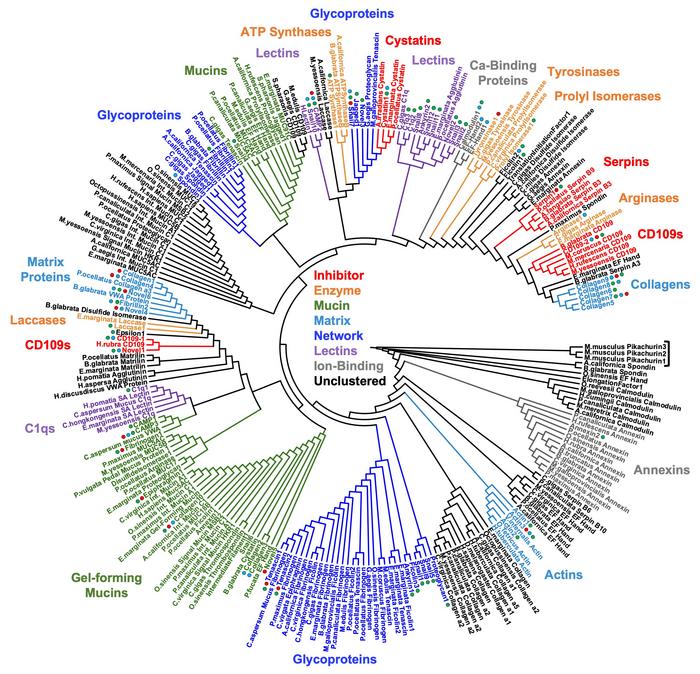NEW YORK, September 5, 2023 — What is snail mucus? That was the question posed by researchers in a new study that examines the molecular composition of snail mucus. When analyzing the mucus of a common garden snail, they found it contained a complex collection of proteins, some identified as entirely novel.

Credit: Antonio Cerullo
NEW YORK, September 5, 2023 — What is snail mucus? That was the question posed by researchers in a new study that examines the molecular composition of snail mucus. When analyzing the mucus of a common garden snail, they found it contained a complex collection of proteins, some identified as entirely novel.
In a newly published paper in Nature Communications, scientists profile the mucus of Cornu aspersum — a species used in beauty product formulation and eaten as escargot — and detail the composition of three unique types of secretions — one that hydrates and protects its skin, another that works as a glue-like adhesive, and another that lubricates to allow the animal to move freely across surfaces.
“We were surprised that the mucus compositions were quite different, despite being produced by the same species,” said lead author Antonio Cerullo, a biochemistry Ph.D. student at the CUNY Graduate Center. “Even more so, the adhesive snail glue and the lubricious snail trail, which have completely opposite purposes, come from the same part of the snail. It was exciting to discover that very subtle differences in mucus compositions have huge impacts on their biological and material properties.”
The researchers say the hydrogels contain ions, sugars, and more than 70 proteins, including enzymes, mucins, lectins, and matrix proteins. About one-third of the proteins found in the mucus shared no similarity with any proteins in the global databases that were searched, said the researchers. In short, the secretions contain many proteins that are unlike any others known to science.
Snail mucus is widely used in cosmetics, moisturizers, anti-aging creams, wound care treatments, and antimicrobials. Beauty products containing snail mucus are a multi-billion-dollar global industry.
There are still many open questions about the macromolecular structure of mucus. Even human mucus, which has been studied much more extensively than snail mucus, is not well understood.
“Everyone is fascinated and disgusted by mucus. However, most people don’t realize just how complex and elegant these secretions are,” said the study’s principal investigator Adam Braunschweig, who is a faculty member with the Nanoscience Initiative at the Advanced Science Research Center at the CUNY Graduate Center (CUNY ASRC) and a professor of chemistry and biochemistry at the Graduate Center and Hunter College.
The data revealed subtle differences that accounted for vast differences in properties of the mucus. One example involves the use of calcium.=
Calcium holds mucus networks together and solidifies the network. As a result, lubricating mucus has the least amount of calcium and the highest amount of calcium-binding proteins, while binding mucus has the opposite composition.
Snail mucus is currently being studied for applications in biomedicine, including surgical glues, as lubricants for eyes, joints, and medical implants, as well as drug delivery systems. More uses of snail mucus are being discovered every day, Braunschweig said.
Xi Chen, a CUNY ASRC researcher and professor at The City College of New York and the Graduate Center and Mandë Holford, a chemistry professor at the CUNY Graduate Center and Hunter College were collaborators on the study.
The study was funded by the National Science Foundation, the Air Force Office of Scientific Research, and the U.S. Space Force. Collaborators were supported by the Office of Naval Research, the Allen Institute, and the National Institutes of Health.
About the Graduate Center of The City University of New York
The CUNY Graduate Center is a leader in public graduate education devoted to enhancing the public good through pioneering research, serious learning, and reasoned debate. The Graduate Center offers ambitious students nearly 50 doctoral and master’s programs of the highest caliber, taught by top faculty from throughout CUNY — the nation’s largest urban public university. Through its nearly 40 centers, institutes, initiatives, and the Advanced Science Research Center, the Graduate Center influences public policy and discourse and shapes innovation. The Graduate Center’s extensive public programs make it a home for culture and conversation.
About the Advanced Science Research Center at the CUNY Graduate Center
The Advanced Science Research Center at the CUNY Graduate Center (CUNY ASRC) is a world-leading center of scientific excellence that elevates STEM inquiry and education at CUNY and beyond. The CUNY ASRC’s research initiatives span five distinctive, but broadly interconnected disciplines: nanoscience, photonics, neuroscience, structural biology, and environmental sciences. The center promotes a collaborative, interdisciplinary research culture where renowned and emerging scientists advance their discoveries using state-of-the-art equipment and cutting-edge core facilities.
Journal
Nature Communications
DOI
10.1038/s41467-023-41094-z
Method of Research
Experimental study
Article Title
Comparative mucomic analysis of three functionally distinct Cornu aspersum Secretions
Article Publication Date
2-Sep-2023




